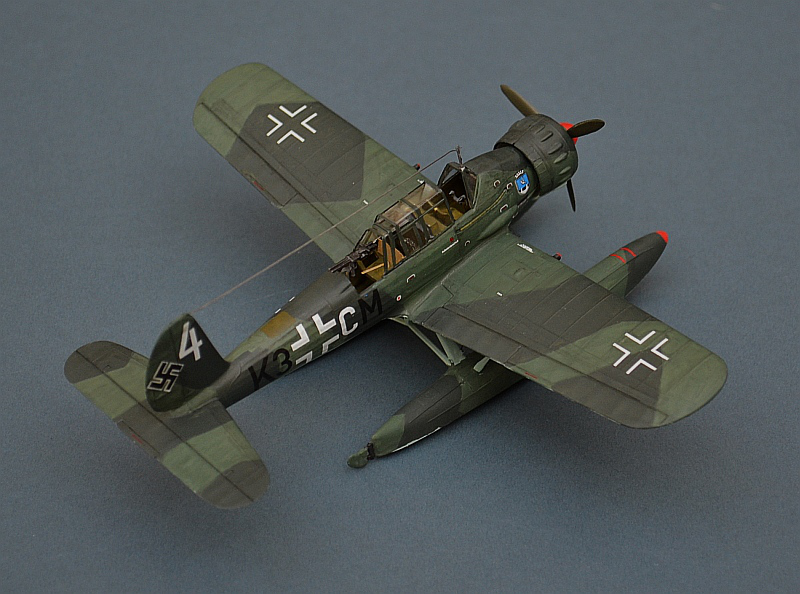Adversaries: WW1 & WW2
Germany.

Most of these aircraft, but not all, have tangled in some way (mostly unsuccessfully)
with the Fleet Air Arm:
Arado Ar 196A-3
Seenotrettungsgruppe 10, Seenotbereitschaftskommando IX,
Tromsoe, Norway February 1944
Revell (Heller) 1/72
The Arado 196 is widely acknowledged as one of the most successful floatplanes of
WW2. First flown in 1936, it equipped major surface units of the Kreigsmarine as
a catapult launched spotter and anti-submarine aircraft, whilst shore-based units
used it for coastal patrols and to intercept large Allied maritime aircraft such
as the Whitley.
Ar 196s operated in all WW2 theatres, from the Mediterranean and North Africa through
to the Arctic. The aircraft represented was part of the Tromso-based patrol force
conducting reconnaissance for the Kreigsmarine surface raiders Scharnhorst and Tirpitz
operating against Allied arctic convoys, as well as patrolling the occupied Norwegian
coastline.
Junkers Ju-88A-4
1/KG30 "Adler Geschwader" , Norway 1941.
Airfix 1/72.
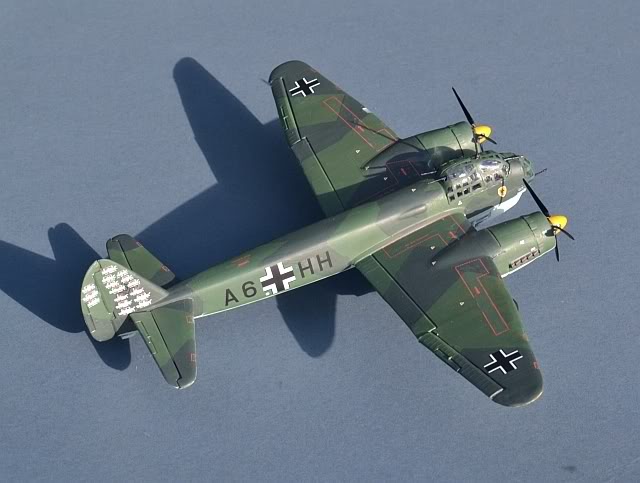
The Ju-88 was one of the most successful German aircraft of WW2, serving on all fronts
in a variety of roles and remaining in production until the end of the war, with
over 16,000 built. The A4 dive-bomber version was used extensively in anti-shipping
roles and took a heavy toll on Allied merchant shipping and Naval vessels .

KG30 conducted the first bombing raids on the UK, attacking the Firth of Forth in
October 1939' followed by the sinking of the troopship RMS Lancastria off St Nazaire
in 1940, with the loss of 5000 lives. This aircraft wears the markings of the 1/KG30
Commander, Werner Baumbach, one of the most decorated bomber pilots of the war. The
tail markings indicate his personal tally, which totalled over 300,000 tons of allied
shipping.
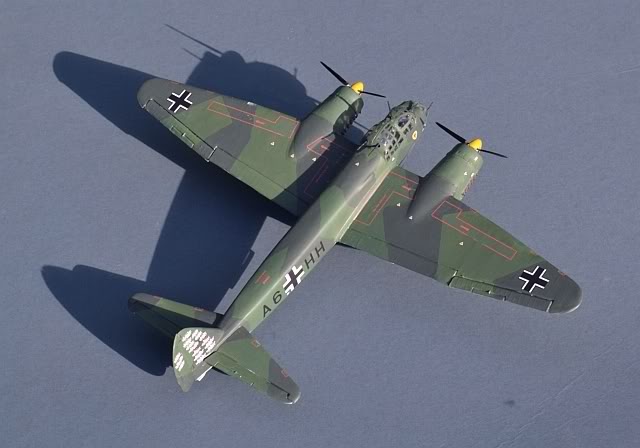
Baumbach saw action during the Battle of Britain, Arctic Convoys and on the Eastern
Front, before taking command of KG200, the Nazi special operations unit that developed
such aircraft as the Mistel and Amerika Bombers. Baumbach died in Argentina in 1953,
still espousing many aspects of Nazi idealogy.I

Messerschmitt Me-163B Komet, 1/JG400, Brandis Airfield Germany 1945
Academy (out the box)
The rocket powered Komet was based around a proven Lippisch glider design, equipped
with a 3,748 lb thrust Walther rocket motor that allowed it to achieve nearly 600
Mph with a flight duration of around 10 minutes. Used as an interceptor against
massed formations of Allied bombers, its very speed proved to be ia serious limitation,
allowing only a brief opportunity for the pilot to attack the bombers before having
to turn around and begin another run. It was also extremely vulnerable during its
landing phase, with many falling prey to Allied fighters that loitered around the
known Me-163 bases.
Flying operationally for the first time in August 1944, the last operational Komet
flight by the Luftwaffe was in April 1945. Komets posed a huge danger to their pilots,
who sat between two ceramic fuel oxidiser tanks, the content of which would devour
their flesh if the tanks shattered during, for example, a landing accident, despite
the complex PVC protective suits that each pilot had to wear. Several were captured
by the Allies at the end of WW2, but due the dangers inherent in its design, the
only known flight was undertaken by the renowned Royal Navy pilot Eric Brown, who
reported it to be a well behaved and agile airframe. Many Komets remain on display
in museums around the world, such as that at the East Fortune Scottish Museum of
Flight and the Cosford RAF Museum.




Heinkel He-162 A-2 Salamander, 3/JG1, Leck Airfield, Germany 1945
FROG (out the box)
The He-162 arose from a September 1944 specification issued by the RLM for a simple
jet-powered fighter to counter the devastating Allied bomber raids that were bringing
Nazi Germany to its knees. Somewhat unrealistically and in growing desperation, the
Nazi hierarchy imagined the “Volksjager” people’s fighter as something that Nazi
Youth could fly with minimal training in defence of the Reich. Armed with two 20mm
cannons, in truth, the He-162 was a well behaved, practical and effective design,
produced in a remarkably short time from contract to flight of only a few months,
but still requiring a well trained pilot to fly it.
It was the fastest of the early jet designs, with a top speed of over 550mph; produced
mainly from wood, its production bypassed late war shortages of strategic materials
such as aluminium,with vast undeground factories established in safe areas, capable
of producing 2,000 aircraft each month, but fortunately, the war ended before this
realistic target could be achieved. By the time of the Nazi surrender on 8 May 1945,
only 120 He-162s had been delivered. A further 200 were completed and awaiting flight-testing
and roughly 600 more were in advanced production.
Operationally, the He-162 was limited in its success by chronic fuel shortages, as
well as successful Allied efforts to attack the German airfields as aircraft were
taking off or landing. Nevertheless, it was a remarkable design, but fortunately
it came too late to alter the result of WW2.
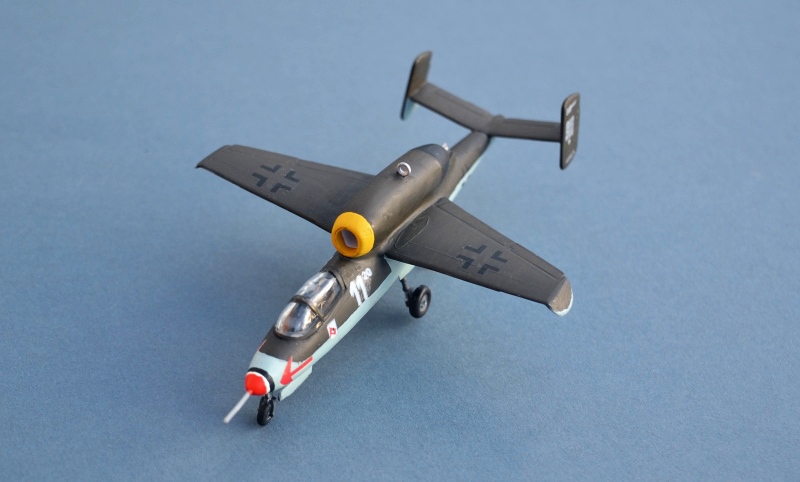



Fieseler Fi-156 Storch, Wüstennotstaffel, Afrika Korps 1942
Airfix (out the box)
The Fiesler Fi-156 Storch served with the Luftwaffe in all theatres during WW2. Used
as an observation/spotter aircraft and as a VIP liaison/transport, it entered service
in 1937 and continued to be manufactured until 1965 (in France as the Morane-Saulnier
Criquet). Although large and heavy, with less maneouverability than its Allied equivalents,
the Storch had a remarkable short take-off and landing performance, with heavy duty
landing gear allowing it to land in very small spaces of rough ground. Over 3,000
were built by the Germans with another 1,000 by the French, Soviets, Romanians and
Czechoslovakia.




Messerschmitt Bf-109-E7, 7/JG26, X Fleigerkorps, Gela, Sicily 1941
Airfix (with Xtradecal markings)
The Bf-109 was one of the most important Nazi aircraft of WW2, fighting on all fronts
and holding the record for the most aircraft shot down . The 109-E or “Emil” model
was introduced just before the invasion of Russia and fought during the Battle of
Britain. The E-7 introduced plumbing to allow an auxiliary fuel tank to be carried
beneath the fuselage (an later a single bomb too). Although generally viewed as
an equivalent of the Spitfire, it was less manoeuvrable, but had a higher ceiling.
As the 109’s war moved more to air to air combat rather than ground support, the
central canon that fired through the engine and propeller hub was generally removed
with the resulting hole in the spinner filled.




Messerschmitt Bf-109-F4, 10(Jabo)/JG53, X Fleigerkorps, Comiso, Sicily 1942
Italeri (with Xtradecal markings)
The F model of the Bf-109 saw the more powerful DB601E engine plus a number of aerodynamic
improvements, including a redesigned and far more streamlined engine cowling. Thes
e increased the aircraft’s range to over 1060 miles with a drop tank and also enabled
its effective use as a fighter bomber (Jabo) . Additional armour and self sealing
fuel tanks improved resilience to battle damage whilst new elliptical wings produced
less drag. The central hub 20mm canon was restored, but the 20mm wing canons were
not and the light 7.62mm nose machine guns drew criticism from many pilots.




Dornier Do-17z, 1/KG3, Battle of Britain / Blitx 1940-41
FROG
The Dornier Do17 made its first flight in 1934 and entered Luftwaffe service in 1937.
As a conventional (i.e. not dive) bomber it lacked the agility of the Ju-88 and
had a lower bomb capacity and range than both the Junkers and He-111, but it was
reliable, its flying characteristics were predictable and it was available in large
numbers (2,193 were built). Production ended in 1940 in favour of more capable types
and its successor, the Do-217, but the Do17 played a large part in the Battle of
Britain and The Blitz, then remained in service as a 2nd line type and trainer until
the end of the WW2.
Popularly known as the Fliegender Bleistift ("flying pencil") due to its narrow aft
fuselage, it was a contemporary of and had a similar design and capabilities to the
Handley Page Hampden', albeit with distinctive shoulder mounted wings . The Do17
Z was the definitive variant, modified and up-powered to reflect lessons learned
during the Spanish Civil War. Fitted with Bramo Fafnir 323 P-2 radial engines, it
was limited by its small bomb load of only 1,000kg, maximum speed of 220 mph and
limited combat range of 410 miles (for comparison, the He-111 could carry 4,000lbs
over 1,000 miles at up to 270 mph and the Ju-88 6,000lbs for up to 1,000 miles at
290 mph).
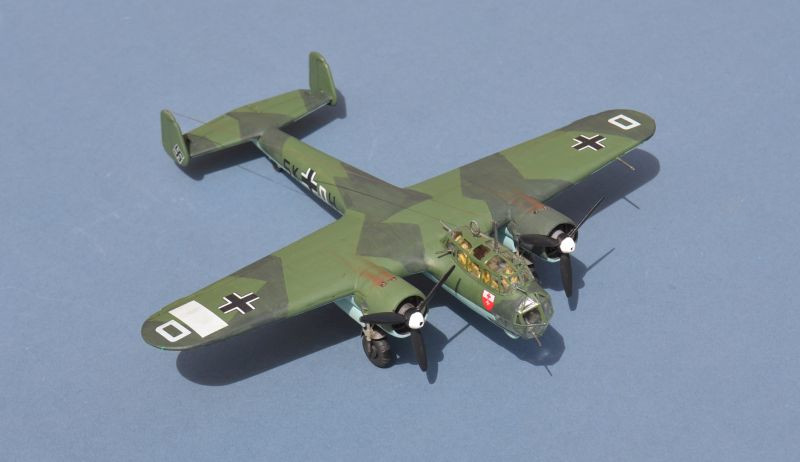


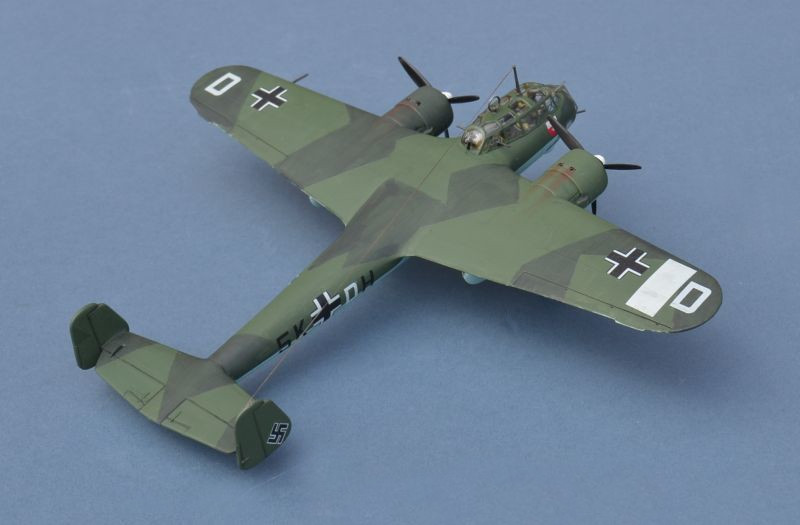
![]()
 Main Index
Main Index



